A Novel Method for Generating H2 by Activation of the μAl-Water System Using Aluminum Nanoparticles
Abstract
:Featured Application
Abstract
1. Introduction
2. Materials and Methods
2.1. Reagents and Materials
2.2. Synthesis of Al NPs
2.3. Characterization of Al NPs
2.4. Hydrolysis Activation Experiments
3. Results and Discussion
3.1. Synthesis and Characterization of Al NPs
3.2. Hydrolysis Activation Study
4. Conclusions
Supplementary Materials
Author Contributions
Funding
Institutional Review Board Statement
Informed Consent Statement
Data Availability Statement
Acknowledgments
Conflicts of Interest
Appendix A
Appendix B
References
- Wang, H.Z.; Leung, D.Y.C.; Leung, M.K.H.; Ni, M. A review on hydrogen production using aluminum and aluminum alloys. Renew. Sustain. Energy Rev. 2009, 13, 845–853. [Google Scholar] [CrossRef]
- Xu, S.; Zhao, X.; Liu, J. Liquid metal activated aluminum-water reaction for direct hydrogen generation at room temperature. Renew. Sustain. Energy Rev. 2018, 92, 17–37. [Google Scholar] [CrossRef]
- Alinejad, B.; Mahmoodi, K. A novel method for generating hydrogen by hydrolysis of highly activated aluminum nanoparticles in pure water. Int. J. Hydrog. Energy 2009, 34, 7934–7938. [Google Scholar] [CrossRef]
- Ma, G.L.; Zhuang, D.W.; Dai, H.; Wang, P. Controlled hydrogen generation by reaction of aluminum with water. Prog. Chem. 2012, 24, 650–658. [Google Scholar]
- Uehara, K.; Takeshita, H.; Kotaka, H. Hydrogen gas generation in the wet cutting of aluminum and its alloys. J. Mater. Process. Technol. 2002, 127, 174–177. [Google Scholar] [CrossRef]
- Elitzur, S.; Rosenband, V.; Gany, A. Study of hydrogen production and storage based on aluminum–water reaction. Int. J. Hydrog. Energy 2014, 39, 6328–6334. [Google Scholar] [CrossRef]
- Sartbaeva, A.; Kuznetsov, V.L.; Wells, S.A.; Edwards, P.P. Hydrogen nexus in a sustainable energy future. Energy Environ. Sci. 2008, 1, 79–85. [Google Scholar] [CrossRef]
- Wang, W.; Zhao, X.M.; Chen, D.M.; Yang, K. Insight into the reactivity of Al–Ga–In–Sn alloy with water. Int. J. Hydrog. Energy 2012, 37, 2187–2194. [Google Scholar] [CrossRef]
- Parmuzina, A.V.; Kravchenko, O.V. Activation of aluminium metal to evolve hydrogen from water. Int. J. Hydrog. Energy 2008, 33, 3073–3076. [Google Scholar] [CrossRef]
- Rosenband, V.; Gany, A. Application of activated aluminum powder for generation of hydrogen from water. Int. J. Hydrog. Energy 2010, 35, 10898–10904. [Google Scholar] [CrossRef]
- Rashid, M.; Al Mesfer, M.; Naseem, H.; Danish, M. Hydrogen production by water electrolysis: A review of alkaline water electrolysis, PEM water electrolysis and high temperature water electrolysis. Int. J. Eng. Adv. Technol. 2015, 4, 80–93. [Google Scholar]
- Kojima, Y.; Suzuki, K.-i.; Fukumoto, K.; Sasaki, M.; Yamamoto, T.; Kawai, Y.; Hayashi, H. Hydrogen generation using sodium borohydride solution and metal catalyst coated on metal oxide. Int. J. Hydrog. Energy 2002, 27, 1029–1034. [Google Scholar] [CrossRef]
- Brown, L.F. A comparative study of fuels for on-board hydrogen production for fuel-cell-powered automobiles. Int. J. Hydrog. Energy 2001, 26, 381–397. [Google Scholar] [CrossRef]
- Sivaramakrishnan, R.; Shanmugam, S.; Sekar, M.; Mathimani, T.; Incharoensakdi, A.; Kim, S.-H.; Parthiban, A.; Edwin Geo, V.; Brindhadevi, K.; Pugazhendhi, A. Insights on biological hydrogen production routes and potential microorganisms for high hydrogen yield. Fuel 2021, 291, 120136. [Google Scholar] [CrossRef]
- Newell, A.; Thampi, K.R. Novel amorphous aluminum hydroxide catalysts for aluminum–water reactions to produce H2 on demand. Int. J. Hydrog. Energy 2017, 42, 23446–23454. [Google Scholar] [CrossRef]
- Torvi, A.; Naik, S.; Kariduraganavar, M. Development of supercapacitor systems based on binary and ternary nanocomposites using chitosan, graphene and polyaniline. Chem. Data Collect. 2018, 17–18, 459–471. [Google Scholar] [CrossRef]
- Thakur, V.K.; Thakur, M.K. Recent advances in graft copolymerization and applications of chitosan: A review. ACS Sustain. Chem. Eng. 2014, 2, 2637–2652. [Google Scholar] [CrossRef]
- Madhumitha, G.; Fowsiya, J.; Mohana Roopan, S.M.; Thakur, V.K. Recent advances in starch–clay nanocomposites. Int. J. Polym. Anal. Charact. 2018, 23, 331–345. [Google Scholar] [CrossRef]
- Casar, G.; Li, X.; Malič, B.; Zhang, Q.M.; Bobnar, V. Impact of structural changes on dielectric and thermal properties of vinylidene fluoride–trifluoroethylene-based terpolymer/copolymer blends. Phys. B Phys. Cond. Matt. 2015, 461, 5–9. [Google Scholar] [CrossRef] [Green Version]
- Veron, F.; Lanoue, F.; Baco-Carles, V.; Kiryukhina, K.; Vendier, O.; Tailhades, P. Selective laser powder bed fusion for manufacturing of 3D metal-ceramic multi-materials assemblies. Addit. Manuf. 2022, 50, 102550. [Google Scholar] [CrossRef]
- Dreizin, E.L. Metal-based reactive nanomaterials. Prog. Energy Combust. Sci. 2009, 35, 141–167. [Google Scholar] [CrossRef]
- Yetter, R.A.; Risha, G.A.; Son, S.F. Metal particle combustion and nanotechnology. Proc. Combust. Inst. 2009, 32, 1819–1838. [Google Scholar] [CrossRef]
- Jelliss, P.A.; Thomas, B.J.; Patel, A. Polymerization passivation strategies for the stabilization of energetic aluminum nanomaterials. Int. J. Chem. 2014, 3, 122–131. [Google Scholar]
- Ates, B.; Koytepe, S.; Ulu, A.; Gurses, C.; Thakur, V.K. Chemistry, structures, and advanced applications of nanocomposites from biorenewable resources. Chem. Rev. 2020, 120, 9304–9362. [Google Scholar] [CrossRef]
- Zeng, W.; Nyapete, C.; Benziger, A.; Jelliss, P.; Buckner, S. Encapsulation of reactive nanoparticles of aluminum, magnesium, zinc, titanium, or boron within polymers for energetic applications. Curr. Appl. Polym. Sci. 2019, 3, 3–13. [Google Scholar] [CrossRef]
- Patel, A.; Becic, J.; Buckner, S.W.; Jelliss, P.A. Reactive aluminum metal nanoparticles within a photodegradable poly(methyl methacrylate) matrix. Chem. Phys. Lett. 2014, 591, 268–272. [Google Scholar] [CrossRef]
- Zeng, W.H.; Buckner, S.W.; Jelliss, P.A. Poly(methyl methacrylate) as an environmentally responsive capping material for aluminum nanoparticles. ACS Omega 2017, 2, 2034–2040. [Google Scholar] [CrossRef] [Green Version]
- Abdelkader, E.M.; Jelliss, P.A.; Buckner, S.W. Main group nanoparticle synthesis using electrical explosion of wires. Nano-Struct. Nano-Objects 2016, 7, 23–31. [Google Scholar] [CrossRef]
- Atmane, Y.A.; Sicard, L.; Lamouri, A.; Pinson, J.; Sicard, M.; Masson, C.; Nowak, S.; Decorse, P.; Piquemal, J.Y.; Galtayries, A.; et al. Functionalization of aluminum nanoparticles using a combination of aryl diazonium salt chemistry and iniferter method. J. Phys. Chem. C 2013, 117, 26000–26006. [Google Scholar] [CrossRef]
- Esmaeili, B.; Chaouki, J.; Dubois, C. Nanoparticle encapsulation by a polymer via in situ polymerization in supercritical conditions. Polym. Eng. Sci. 2012, 52, 637–642. [Google Scholar] [CrossRef]
- Ghanta, S.R.; Muralidharan, K. Solution phase chemical synthesis of nano aluminium particles stabilized in poly(vinylpyrrolidone) and poly(methylmethacrylate) matrices. Nanoscale 2010, 2, 976–980. [Google Scholar] [CrossRef] [PubMed]
- Ghanta, S.R.; Muralidharan, K. Chemical synthesis of aluminum nanoparticles. J. Nanopart. Res. 2013, 15, 1715. [Google Scholar] [CrossRef]
- Gottapu, S.; Padhi, S.K.; Krishna, M.G.; Muralidharan, K. Poly(vinylpyrrolidone) stabilized aluminum nanoparticles obtained by the reaction of SiCl4 with LiAlH4. New J. Chem. 2015, 39, 5203–5207. [Google Scholar] [CrossRef]
- Huang, X.Y.; Jiang, P.K.; Kim, C.N.; Ke, Q.Q.; Wang, G.L. Preparation, microstructure and properties of polyethylene aluminum nanocomposite dielectrics. Compos. Sci. Technol. 2008, 68, 2134–2140. [Google Scholar] [CrossRef]
- Huang, X.Y.; Kim, C.N.; Ma, Z.S.; Jiang, P.K.; Yin, Y.; Li, Z. Correlation between rheological, electrical, and microstructure characteristics in polyethylene/aluminum nanocomposites. J. Polym. Sci. Polym. Phys. 2008, 46, 2143–2154. [Google Scholar] [CrossRef]
- Huang, X.Y.; Ma, Z.S.; Wang, Y.Q.; Jiang, P.K.; Yin, Y.; Li, Z. Polyethylene/aluminum nanocomposites: Improvement of dielectric strength by nanoparticle surface modification. J. Appl. Polym. Sci. 2009, 113, 3577–3584. [Google Scholar] [CrossRef]
- Madhankumar, A.; Nagarajan, S.; Rajendran, N.; Nishimura, T. EIS evaluation of protective performance and surface characterization of epoxy coating with aluminum nanoparticles after wet and dry corrosion test. J. Solid State Electrochem. 2012, 16, 2085–2093. [Google Scholar] [CrossRef]
- Nishimura, T.; Raman, V. Corrosion prevention of aluminum nanoparticles by a polyurethane coating. Materials 2014, 7, 4710–4722. [Google Scholar] [CrossRef] [Green Version]
- Nishimura, T.; Raman, V. Epoxy polymer coating to prevent the corrosion of aluminum nanoparticles. Polym. Advan. Technol. 2016, 27, 712–717. [Google Scholar] [CrossRef]
- Zeng, W.; Jelliss, P.A.; Buckner, S.W. Synthesis and hydrogen production kinetics of temperature-responsive aluminum-poly(N-isopropylacrylamide) core-shell nanoparticles. Mater. Chem. Phys. 2018, 220, 233–239. [Google Scholar] [CrossRef]
- Chung, S.W.; Guliants, E.A.; Bunker, C.E.; Hammerstroem, D.W.; Deng, Y.; Burgers, M.A.; Jelliss, P.A.; Buckner, S.W. Capping and passivation of aluminum nanoparticles using alkyl-substituted epoxides. Langmuir 2009, 25, 8883–8887. [Google Scholar] [CrossRef] [PubMed]
- Hammerstroem, D.W.; Burgers, M.A.; Chung, S.W.; Guliants, E.A.; Bunker, C.E.; Wentz, K.M.; Hayes, S.E.; Buckner, S.W.; Jelliss, P.A. Aluminum nanoparticles capped by polymerization of alkyl-substituted epoxides: Ratio-dependent stability and particle size. Inorg. Chem. 2011, 50, 5054–5059. [Google Scholar] [CrossRef] [PubMed]
- Jelliss, P.A.; Buckner, S.W.; Chung, S.W.; Patel, A.; Guliants, E.A.; Bunker, C.E. The use of 1,2-epoxyhexane as a passivating agent for core-shell aluminum nanoparticles with very high active aluminum content. Solid State Sci. 2013, 23, 8–12. [Google Scholar] [CrossRef]
- Wang, H.-W.; Chin, M.-S. Rapid hydrogen generation from aluminum-water system using synthesized aluminum hydroxide catalyst. Int. J. Chem. Eng. Appl. 2015, 6, 146–151. [Google Scholar] [CrossRef] [Green Version]
- Chen, Y.-K.; Teng, H.-T.; Lee, T.-Y.; Wang, H.-W. Rapid hydrogen generation from aluminum–water system by adjusting water ratio to various aluminum/aluminum hydroxide. Int. J. Energy Environ. Eng. 2014, 5, 87. [Google Scholar] [CrossRef] [Green Version]
- Prabu, S.; Hsu, S.C.; Lin, J.S.; Wang, H.W. Rapid hydrogen generation from the reaction of aluminum powders and water using synthesized aluminum hydroxide catalysts. Top. Catal. 2018, 61, 1633–1640. [Google Scholar] [CrossRef]
- Teng, H.-T.; Lee, T.-Y.; Chen, Y.-K.; Wang, H.-W.; Cao, G. Effect of Al(OH)3 on the hydrogen generation of aluminum–water system. J. Power Sources 2012, 219, 16–21. [Google Scholar] [CrossRef]
- Thomas, B.J.; Bunker, C.E.; Guliants, E.A.; Hayes, S.E.; Kheyfets, A.; Wentz, K.M.; Buckner, S.W.; Jelliss, P.A. Synthesis of aluminum nanoparticles capped with copolymerizable epoxides. J. Nanopart. Res. 2013, 15, 1729. [Google Scholar] [CrossRef]
- Glotov, O.G.; Zyryanov, V.Y. The effect of pressure on characteristics of condensed combustion products of aluminized solid propellant. Arch. Combust. 1991, 11, 251–262. [Google Scholar]
- Yang, S.-P.; Tsai, R.-Y. Complexometric titration of aluminum and magnesium ions in commercial antacids. An experiment for general and analytical chemistry laboratories. J. Chem. Ed. 2006, 83, 906–909. [Google Scholar] [CrossRef]
- Digne, M.; Sautet, P.; Raybaud, P.; Toulhoat, H.; Artacho, E. Structure and stability of aluminum hydroxides: A theoretical study. J. Phys. Chem. B 2002, 106, 5155–5162. [Google Scholar] [CrossRef]
- Chung, S.W.; Guliants, E.A.; Bunker, C.E.; Jelliss, P.A.; Buckner, S.W. Size-dependent nanoparticle reaction enthalpy: Oxidation of aluminum nanoparticles. J. Phys. Chem. Solids 2011, 72, 719–724. [Google Scholar] [CrossRef]
- Dupiano, P.; Stamatis, D.; Dreizin, E.L. Hydrogen production by reacting water with mechanically milled composite aluminum-metal oxide powders. Int. J. Hydrog. Energy 2011, 36, 4781–4791. [Google Scholar] [CrossRef]
- Xiao, F.; Guo, Y.; Li, J.; Yang, R. Hydrogen generation from hydrolysis of activated aluminum composites in tap water. Energy 2018, 157, 608–614. [Google Scholar] [CrossRef]
- Jia, Y.; Shen, J.; Meng, H.; Dong, Y.; Chai, Y.; Wang, N. Hydrogen generation using a ball-milled Al/Ni/NaCl mixture. J. Alloys Comp. 2014, 588, 259–264. [Google Scholar] [CrossRef]
- Ilyukhina, A.V.; Ilyukhin, A.S.; Shkolnikov, E.I. Hydrogen generation from water by means of activated aluminum. Int. J. Hydrog. Energy 2012, 37, 16382–16387. [Google Scholar] [CrossRef]
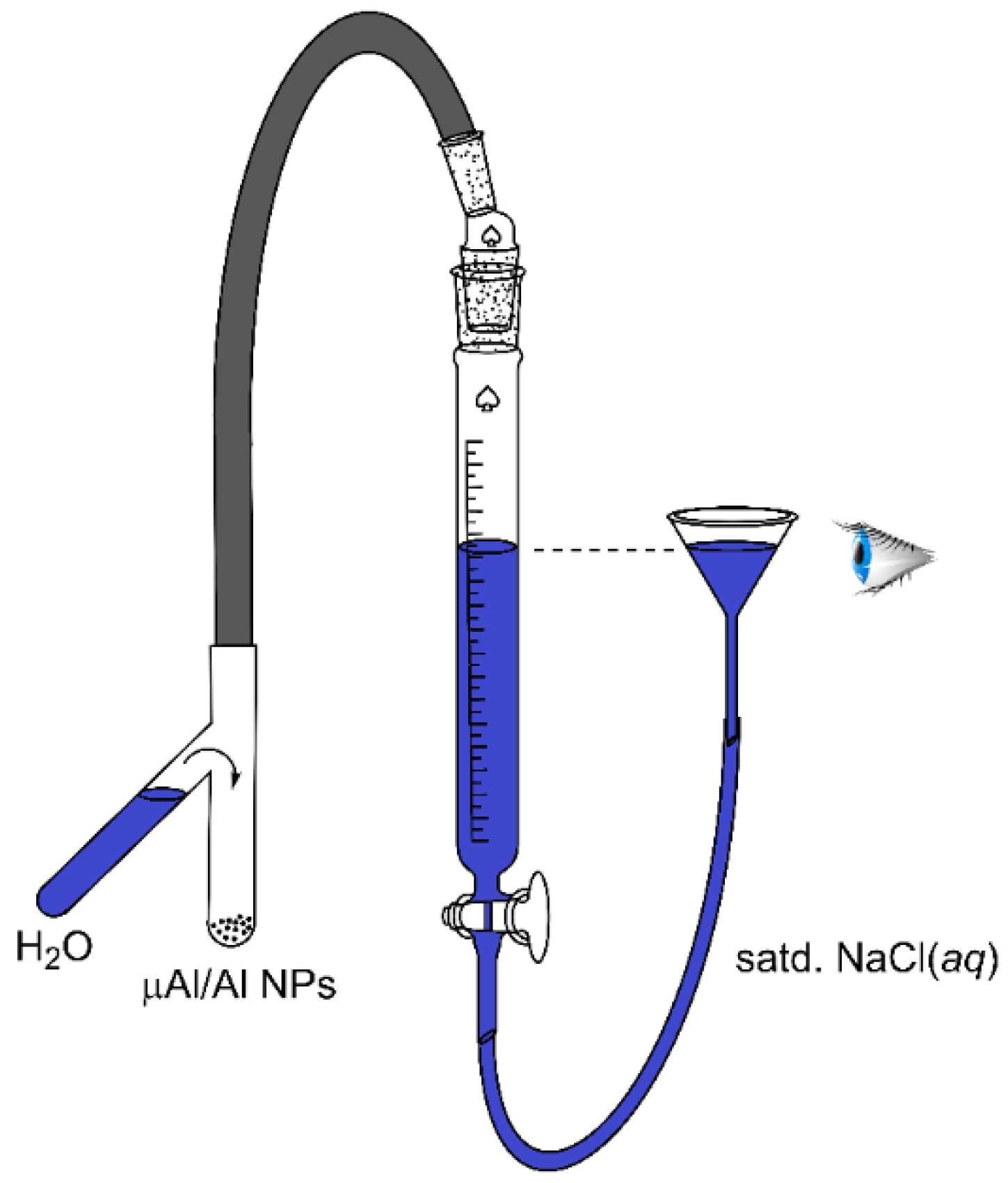
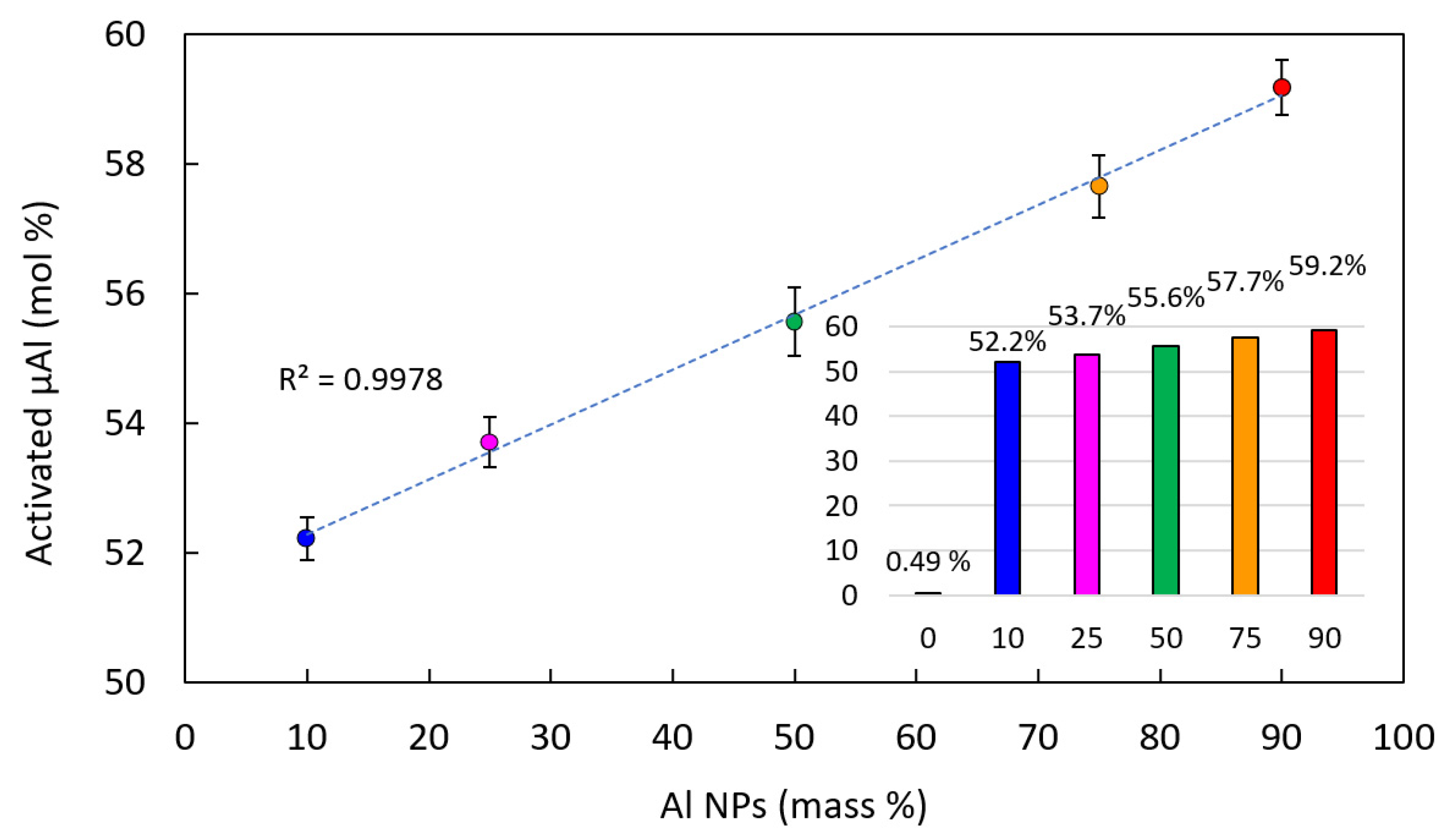
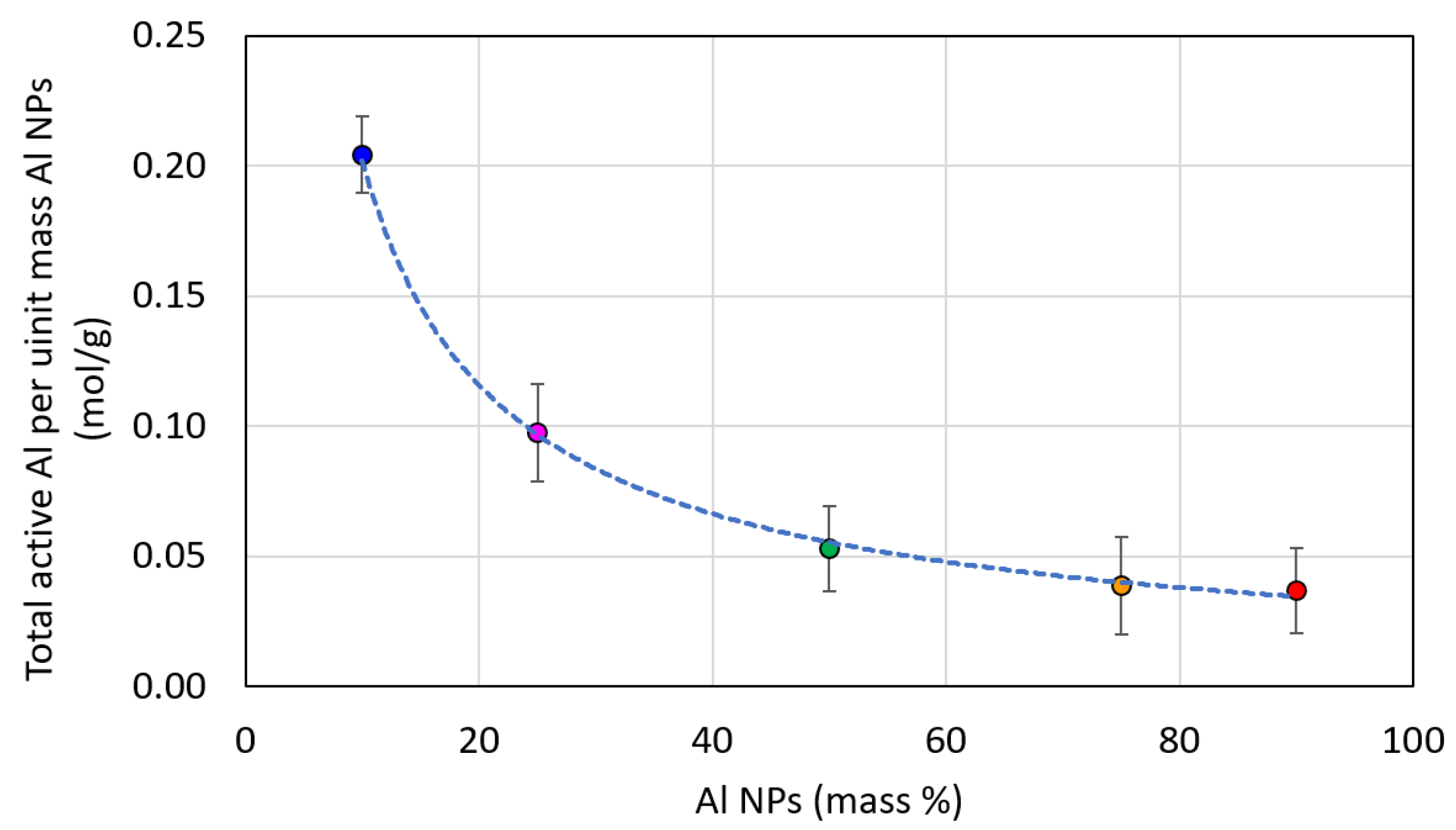
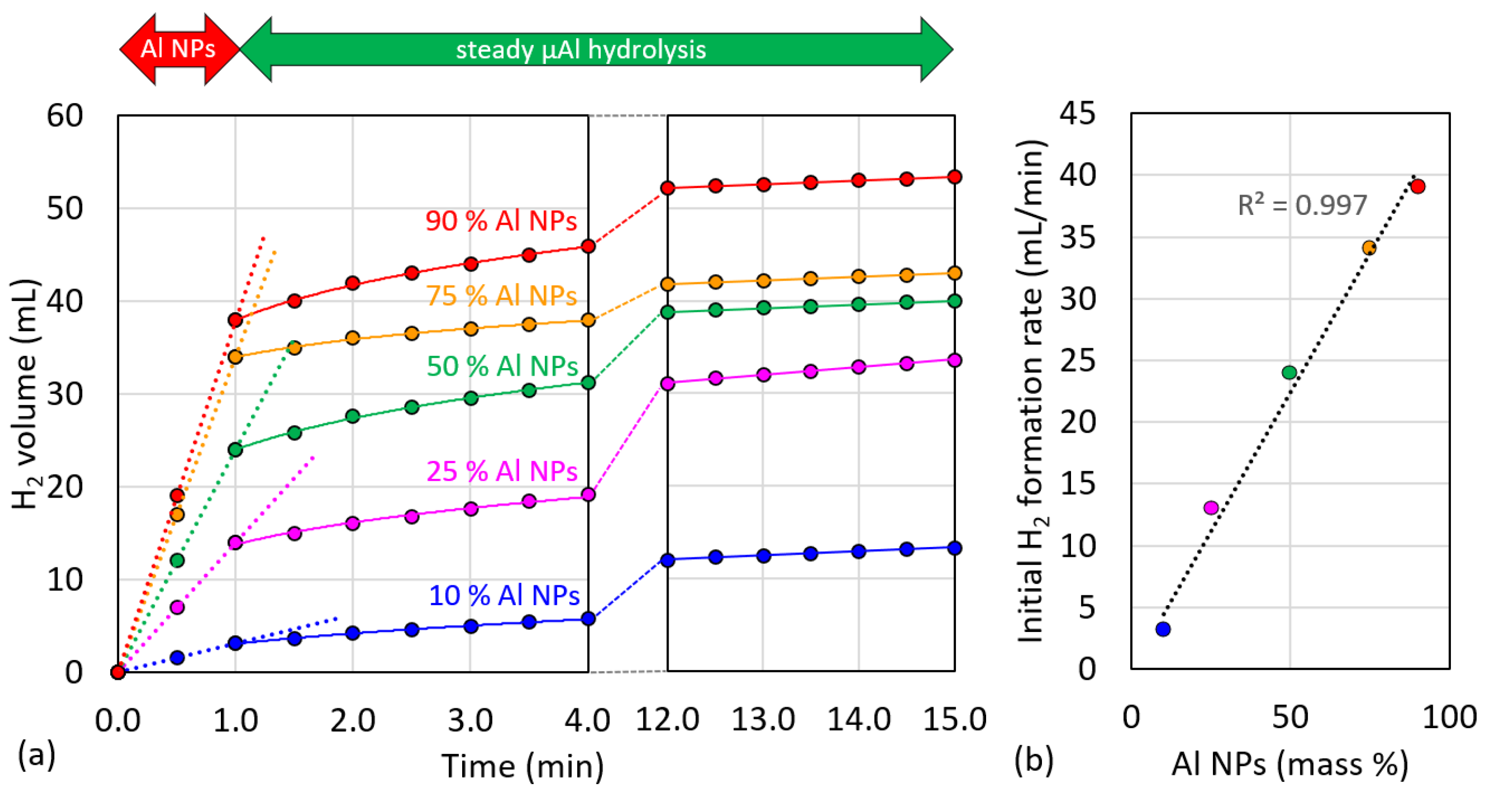


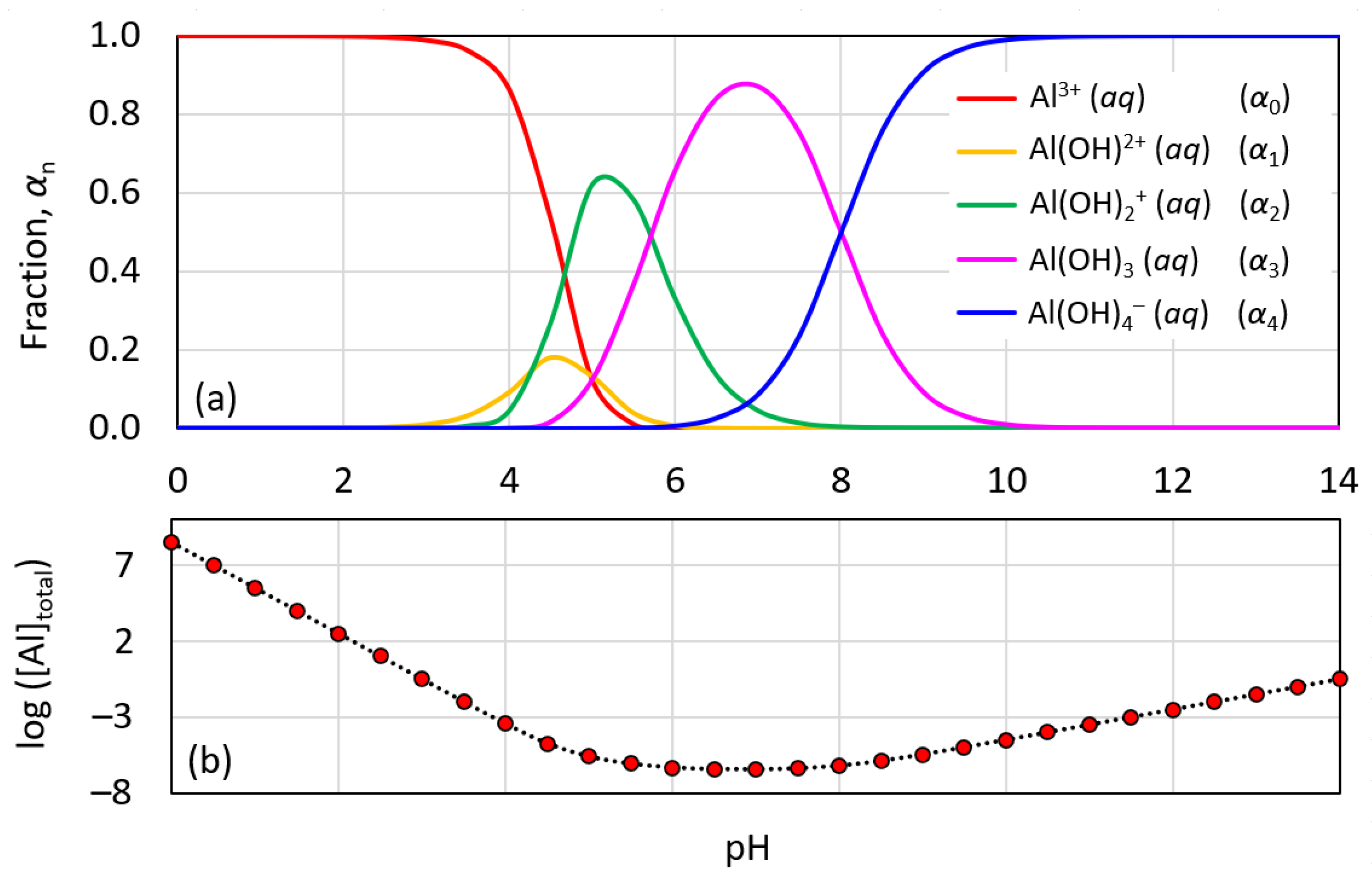
Publisher’s Note: MDPI stays neutral with regard to jurisdictional claims in published maps and institutional affiliations. |
© 2022 by the authors. Licensee MDPI, Basel, Switzerland. This article is an open access article distributed under the terms and conditions of the Creative Commons Attribution (CC BY) license (https://creativecommons.org/licenses/by/4.0/).
Share and Cite
Kader, M.S.; Zeng, W.; Johnston, E.; Buckner, S.W.; Jelliss, P.A. A Novel Method for Generating H2 by Activation of the μAl-Water System Using Aluminum Nanoparticles. Appl. Sci. 2022, 12, 5378. https://doi.org/10.3390/app12115378
Kader MS, Zeng W, Johnston E, Buckner SW, Jelliss PA. A Novel Method for Generating H2 by Activation of the μAl-Water System Using Aluminum Nanoparticles. Applied Sciences. 2022; 12(11):5378. https://doi.org/10.3390/app12115378
Chicago/Turabian StyleKader, Mohammad S., Wenhui Zeng, Elisabeth Johnston, Steven W. Buckner, and Paul A. Jelliss. 2022. "A Novel Method for Generating H2 by Activation of the μAl-Water System Using Aluminum Nanoparticles" Applied Sciences 12, no. 11: 5378. https://doi.org/10.3390/app12115378






